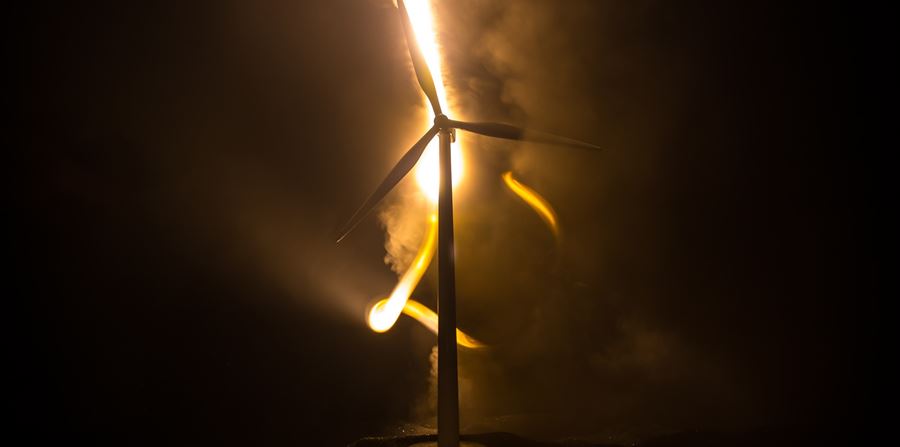Lightning Damage to Wind Turbine

As wind turbines are often the tallest structures sited on large, flat landscapes, lighting attachment doesn’t just come as a risk but is expected. All components of modern wind turbines are designed to attract and conduct lightning to the ground and away from its sensitive parts. The wind turbine blade has at least two metal receptors designed as lightning attachment points. These receptors are typically located at the blade’s tip and near the blade’s middle. These receptors connect a conductor from the blade’s root, where the lightning current is channeled, through the cast iron hub and transferred to the nacelle grounded lightning conductor. When in working order, the lightning protection system (LPS) can channel up to 200,000 Amps from the lightning strike to the ground. A properly designed and maintained LPS is critical to a wind turbine’s survival.
Texas Wind Turbine Catches Fire After Lightning Strike
In this video, a fire initiated towards the middle of the wind turbine blade. As there were no actively energized electrical or hydraulic components in this area of the blade, lightning attachment is a prime suspect as the root cause of the fire. Without closely inspecting the blade and only watching the video, there are a few speculations a forensic investigator can make about the origin of this fire:
- The magnitude of the lightning strike exceeded the Amp capacity of the LPS.
- The lightning attached directly to the blade and not to the lightning receptor.
- The LPS was not properly installed or maintained, and the lightning current could not be conducted safely to the ground.
Causes of Texas Wind Turbine Blade Fire
A wind turbine blade is constructed with fiberglass, resin, and balsa wood, which is the fuel that can sustain a fire when hit with a high enough ignition source. After lighting strikes the wind turbine blade in the video, a fire is ignited by the high heat of the lightning. The turbine continues to operate as the fire spreads because no alarm thresholds have been exceeded. After the blade separates, the turbine likely registers a vibration alarm and begins to shut down the turbine. A large burning blade fragment is seen draped over the turbine nacelle, indicating that the fire may have spread to the nacelle cover. Most nacelle covers are made of fiberglass and resin, if the nacelle was constructed of steel, the damage might have been limited to just the blade.
Repair Options for Wind Turbine Blades
When a wind turbine blade fails, all three blades should be replaced since the blades are built in balanced sets of three. It is not impossible to find a single replacement blade that matches the two undamaged blades, but it is likely that weight would need to be added to the blade to ensure the balance of the entire set. Additionally, an engineering analysis is required to ensure the rotor moment is within specification.
Whether replacing a single blade or an entire rotor, these replacements require a large main erection crane for repair. The crane cost is almost always the most expensive tool needed to perform repairs.
Common Failures in a Wind Turbine
Outside of lightning strikes, electrical and mechanical failures can also cause fires in the wind turbine. The generator conductor, brake disc caliper, bearing, and slip ring are some components that can fail and ignite flammable materials in the nacelle. The wind turbine controller monitors the temperature and status of nearly all wind turbine components. Proper analysis of the wind turbine event and alarm logs can provide the necessary insight to determine the cause of the loss.
Nuestros consultores están listos para ayudar.
